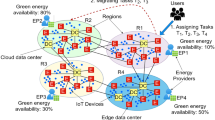Abstract
The increasing use of wireless Internet and smartphone has accelerated the need for pervasive and ubiquitous computing (PUC). Smartphones stimulate growth of location-based service and mobile cloud computing. However, smartphone mobile computing poses challenges because of the limited battery capacity, constraints of wireless networks and the limitations of device. A fundamental challenge arises as a result of power-inefficiency of location awareness. The location awareness is one of smartphone’s killer applications; it runs steadily and consumes a large amount of power. Another fundamental challenge stems from the fact that smartphone mobile devices are generally less powerful than other devices. Therefore, it is necessary to offload the computation-intensive part by careful partitioning of application functions across a cloud. In this paper, we propose an energy-efficient location-based service (LBS) and mobile cloud convergence. This framework reduces the power dissipation of LBSs by substituting power-intensive sensors with the use of less-power-intensive sensors, when the smartphone is in a static state, for example, when lying idle on a table in an office. The substitution is controlled by a finite state machine with a user-movement detection strategy. We also propose a seamless connection handover mechanism between different access networks. For convenient on-site establishment, our approach is based on the end-to-end architecture between server and a smartphone that is independent of the internal architecture of current 3G cellular networks.
Similar content being viewed by others
References
WiMAX (2008) Through 2013—An Evolution to 802.16m, http://www.researchandmarkets.com/reports/577457/wimax_2008_through_2013_an_evolution_to_802.pdf
Open handset alliance. http://www.openhandsetalliance.com/
Vance J (2011) Mobile cloud computing: 5 key trends, http://itmanagement.earthweb.com/netsys/article.php/3922856/Mobile-Cloud-Computing-5-Key-Trends.htm, January 31, 2011
SAMSUNG Galaxy S, http://www.samsung.com/global/microsite/galaxys/
Facebook. http://www.facebook.com/
Myspace. http://www.myspace.com/
Twitter. http://www.twitter.com/
Azizyan M, Choudhury RR (2009) Surroundsense mobile phone localization using ambient sound and light. SIGMOBILE Mob Comput Commun Rev 13(1):69–72
Brezmes T, Gorricho J-L, Cotrina J (2009) Activity recognition from accelerometer data on a mobile phone. In: Proceedings of IWANN ’09, Salamanca, Spain
Györbíró N, Fábián A, Hományi G (2009) An activity recognition system for mobile phones. Mob Netw Appl 14(1):82–91
Lester J, Choudhury T, Borriello G, Consolvo S, Landay J, Everitt K, Smith I (2005) Sensing and modeling activities to support physical fitness. In: Proceedings of UbiComp ’05, Tokyo, Japan
Campbell AT, Eisenman SB, Fodor K, Lane ND, Lu H, Miluzzo E, Musolesi M, Peterson RA, Zheng X (2008) Transforming the social networking experience with sensing presence from mobile phones. In: Proceedings of ACM SenSys ’08, Raleigh, NC, USA
Gellersen HW, Schmidt A, Beigl M (2002) Multi-sensor context-awareness in mobile devices and smart artifacts. Mob Netw Appl 7(5):341–351
Kang S, Lee J, Jang H, Lee H, Lee Y, Park S, Park T, Song J (2008) Seemon: scalable and energy-efficient context monitoring framework for sensor-rich mobile environments. In: Proceedings of ACM MobiSys ’08, Breckenridge, CO, USA
Miluzzo E, Lane ND, Fodor K, Peterson R, Lu H, Musolesi M, Eisenman SB, Zheng X, Campbell AT (2008) Sensing meets mobile social networks: The design, implementation and evaluation of the CenceMe application. In: Proceedings of ACM SenSys ’08 Raleigh, NC, USA
Wang Y, Lin J, Annavaram M, Jacobson QA, Hong J, Krishnamachari B, Sadeh N (2009) A framework of energy efficient mobile sensing for automatic user state recognition. In: Proceedings of ACM MobiSys ’09, Kraków, Poland
Choi M Monitoring application: Battery status monitoring application (available at http://sns.cbnu.ac.kr/batterymon)
Nicholson AJ, Noble BD (2008) Breadcrumbs: Forecasting mobile connectivity. In: Proceedings of 14th ACM international conference on mobile computing and networking (MobiCom’08)
Zheng Y, Li Q, Chen Y, Xie X, Ma W-Y (2008) Understanding mobility based on GPS data. In: UbiComp’08: proceedings of the 10th international conference on ubiquitous computing
Sohn T, Varshavsky A, LaMarca A, Chen MY, Choudhury T, Smith I, Consolvo S, Hightower J, Griswold WG, de Lara E (2006) Mobility detection using everyday GSM traces. In: UbiComp’06: proceedings of the 8th international conference on ubiquitous computing
Basney J, Livny M, Buyya R (1999) Deploying a high throughput computing cluster. Prentice Hall, New York
Stellner G (1996) Cocheck: Checkpointing and process migration for MPI. In: Proceedings of the 10th international parallel processing symposium, Honolulu, Hawaii, April 15–19
Bubendorfer K (1996) Resource based policies for load distribution. Master’s thesis. Victoria University of Wellington
Khalidi YA, Bernabeu JM, Matena V, Shirriff K, Thadani M (1995) Solaris MC: a multi-computer OS. Sun Microsystems Laboratories Technical Paper, Nov. 1995
Ong I, Lim H (2011) Dynamic load balancing and network adaptive virtual storage service for mobile appliances. Int J Inf Proces Syst 7(1):53–62
Author information
Authors and Affiliations
Corresponding author
Rights and permissions
About this article
Cite this article
Choi, M., Park, J. & Jeong, YS. Mobile cloud computing framework for a pervasive and ubiquitous environment. J Supercomput 64, 331–356 (2013). https://doi.org/10.1007/s11227-011-0681-6
Published:
Issue Date:
DOI: https://doi.org/10.1007/s11227-011-0681-6




